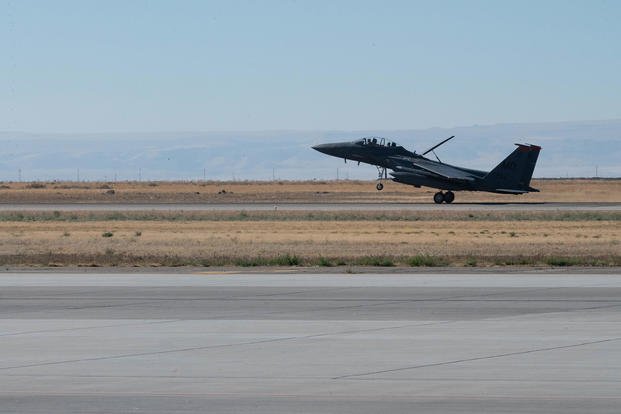Conservation Groups Sue Air Force to Bar Low-Altitude F-15 Flights over Owyhee Wilderness in Oregon, Idaho and Nevada


Oregon, Nevada and Idaho conservationists are suing the U.S. Air Force, arguing that expanded low-altitude F-15 fighter jet flights over the Owyhee Canyonlands will harm the “quiet and solitude” of the vast high-desert region.
The three groups who filed the suit Monday are Oregon Natural Desert Association, Friends of Nevada Wilderness and Idaho Conservation League.
They argue that the Air Force decision to “intensify” the F-15 trainings in the Owyhee airspace will increase noise, fire risk and harm habitat across the 7.5 million acres in the far southeastern corner of Oregon stretching into Nevada and Idaho.
“By flying lower than the top of a tall tree, military jets will dramatically increase noise levels and permanently alter the soundscape throughout these rural and wild areas of national significance,” the suit says. “Resulting noise levels and visual intrusions will disturb and harm people who work or recreate outside, along with iconic but imperiled species like bighorn sheep and sage-grouse.”
The Air Force said it considered public comments and conducted an environmental impact review before approving its plan and took steps to reduce harm to the area.
The Air Force “has adopted all practicable means to avoid or minimize environmental harm from the alternatives selected. However, some adverse impacts cannot be avoided, and could be perceived as adverse or annoying to affected individuals,” its adopted plan says.
Mountain Home Air Force Base in southwestern Idaho provides combat air training and combat support to U.S. forces and allies. Its planes fly over portions of Idaho, Oregon and Nevada.
Military planes have been training in the Owyhee wilderness since the airfield opened in August 1942. Now, primarily F-15E Strike Eagle planes train at the base.
The new plan, approved by the Federal Aviation Administration, will allow the jets to fly at an altitude of 100 feet above ground level at subsonic speeds in the military operations areas in Oregon and Nevada.
Such low-altitude training is now allowed in only two sections of Idaho’s southwest corner, known as Owyhee North and Jarbidge North.
The Air Force says the expanded low-altitude training will allow pilots to obtain proficiency flying in mountainous terrain that reflects the current combat environment, according to its records.
Higher floors now in place for such training — ranging from 10,000 feet to 30,000 feet — create “unrealistic airspace shelves” that prevent pilots from becoming proficient in low-altitude “ingress, threat reactions and egress,” according to the Air Force decision, signed in July by Robert E. Moriarty, deputy assistant secretary of the Air Force.
The Air Force’s plan will also lower the supersonic altitude floor from 30,000 feet to 10,000 feet in what’s called the Paradise North military operation area in Oregon, the Paradise South military operation area in Nevada and Owyhee South and Jarbridge South areas in Idaho. Yet such supersonic operations will still be prohibited over the Duck Valley Indian Reservation that straddles Idaho and Nevada.
The Air Force said it has included flight restrictions for “peak floating” timeframes on scenic rivers in Oregon, including the North Fork Owyhee, Owyhee and Little West Owyhee rivers, and other rivers in Nevada.
Military operations from the base also will be closed during peak holiday recreation, including for Memorial Day, July Fourth and Labor Day, according to the Air Force plan.
The conservation groups counter in the suit that the steps aren’t sufficient and the expansion of low-altitude flights will particularly harm Oregon and Nevada.
“In these states, military jets may now fly as low as 100 feet above the ground –– lower than a tall tree — at subsonic speeds, and as low as 10,000 feet above ground level at supersonic speeds. This is a massive change, allowing fighter jets to fly three times closer to the ground at supersonic speeds and an astounding 30 times closer to the ground at subsonic speeds,” the suit says.
In Oregon, approximately 6,838 supersonic operations and sonic booms will occur annually, or nearly 19 a day, the groups estimate in the suit. About 15% of those training flights will occur at night, between 10 p.m. and 7 a.m., the suit says.
While the Owyhee Canyonlands are sparsely populated by humans, they’re teeming with wildlife and are a “natural treasure” that draws people for hiking, camping, stargazing, fishing, hunting, skiing, rock climbing, river floating, rafting, boating and other outdoor recreational pursuits, the conservation groups said.
The Air Force’s environmental impact study “failed also to disclose how frightening and disruptive a low-level overflight — just 100 feet above the ground — will be to people recreating in these remote and quiet areas,” the suit says.
The suit asks the court to halt the Air Force’s expanded low-altitude training flights and complete a “well-informed and meaningful” public review of the associated environmental problems they will cause, according to Mark Salvo, conservation director at Oregon Natural Desert Association.
Salvo said the groups are also concerned that the jets will drop nearly 40,000 bundles of chaff, aluminum-coated glass fibers released in packets as a measure to counter enemy radars, as well as flares, infrared material that illuminates to counter surface-to-air or air-to-air missiles, polluting clean streams and creating a wildfire hazard.
This isn’t the first time the Air Force has sought to expand its flights and faced opposition from environmental groups in that region.
In 1989, the Air Force proposed a major expansion of operations within Idaho. At that time, ranchers, conservationists, recreationists, scientists, hunters, anglers and the Shoshone Bannock Tribe of Duck Valley raised serious concerns about the impact and damage to public, private and tribal lands and resources.
The Air Force reached a settlement agreement in 1999, approved by a federal judge in Idaho, that placed restrictions on its airspace operations within Idaho. It allowed some low-altitude flights in the Idaho Owyhee region during April, May and June, but flights below 10,000-feet were barred in Oregon and Nevada.
The new lawsuit argues that the Air Force didn’t adequately address concerns raised by the public or expert agencies, including the Oregon Department of Fish and Wildlife, didn’t consider adequate alternatives and meaningful mitigation measures or provide adequate public notice or participation in the environmental impact study.
The Air Force held four public meetings in-person in Idaho, but none in Oregon or Nevada, after it announced its intent in late 2019 to prepare an environmental impact study for expanded training, according to the groups. After the Air Force issued a draft of the environmental impact report in 2021, it hosted three in-person public hearings in Idaho and a virtual webcast but never held public meetings in Oregon or Nevada, the suit says.
The Air Force received 2,894 public comments on the draft. Most of those cited concerns about the impact on wildlife, particularly sage grouse, migratory birds, bighorn sheep and other big game; effects from sonic booms on humans and structures; impacts to tribal communities; the potential for increased wildfire from expelled flares; adverse effects on recreational activities and tourism; and adverse effects on the nationally recognized wilderness areas, according to the suit.
The Air Force did acknowledge that the expansion of low-altitude training in the region would likely result in missions involving other non- Mountain Home-based aircraft using the air space over time, its plan said.
While the Air Force has argued in its public records that existing altitude floors don’t provide adequate opportunities for pilots to obtain low-altitude certification and training in mountainous areas, the agencies who filed suit argue that the Air Force should look elsewhere.
“Similar training opportunities are available at other airbases and ranges that do not possess the same nationally unique and largely undisturbed characteristics of the Owyhee Canyonlands,” the suit says.
The suit was filed Monday in federal court in Pendleton.
— Maxine Bernstein
©2024 Advance Local Media LLC. Visit oregonlive.com. Distributed by Tribune Content Agency, LLC.
© Copyright 2024 oregonlive.com. All rights reserved. This material may not be published, broadcast, rewritten or redistributed.





